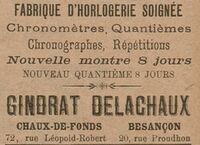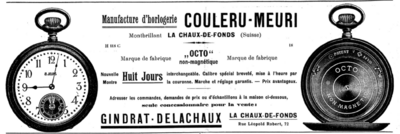Gindrat-Delachaux
Gindrat-Delachaux was a watchmaking firm established in La Chaux-de-Fonds by 1893 to produce 8-day watches and clocks. André Gindrat-Delachaux worked with Charles Couleru-Meuri to patent an improved winding system and barrel for these clocks in 1903 and his firm became very successful in the first quarter of the 20th century. The company was taken over by Arthur Aubry-Gostely (son of Hebdomas inventor Irénee Aubry) in 1924. After a 1933 bankruptcy the firm was merged with Montres Brigos, and was a leading producer of 8-day clocks, travel clocks, and alarm clocks until switching to wristwatches and telephone meters in the 1960s. Brigos was liquidated in 1977.
Gindrat-Delachaux
Louis-Alfred Gindrat of Tramelan-Dessus moved to La Chaux-de-Fonds and both of his sons joined the watchmaking trade. André Gindrat married a Delachaux and took her last name while his brother Albert Gindrat worked under his father's name alone.
The firm of Gindrat-Delachaux was established in La Chaux-de-Fonds at Boulevard du Petit Château 17 in 1893 according to later materials and was listed in primary sources that year. The company was run by André Gindrat-Delachaux of Tramelan and shared the famous Montbrillant Watch Manufactory building with Breitling and Couleru-Meuri. He acquired the patented for a novel calendar mechanism for watches from Rénold Kocher, industrialist from Bévilard, that same year.
Huitaine

In 1896 Gindrat-Delachaux announced the availability of a new 8-day watch. By this date the firm had moved from Montbrillant to Rue Léopold-Robert 72, a more metropolitan location with less room for manufacturing. This suggests that the new watch movement was constructed by a partner, likely former neighbor Couleru-Meuri.
Gindrat-Delachaux collaborated with Charles Couleru-Meuri on two patents in 1903. The first, CH28244, covered a novel crown winding mechanism while the second, CH29070, was for a long power reserve barrel. This was sold using the Octo brand by Couleru-Meuri, but Gindrat-Delachaux used another name: Huitaine, meaning "about a week" in French. In 1908 the firm registered Huitaine as a brand and added "Fabrique Huitaine" to the name, reflecting the importance of this product.

The firm distributed an 8-day watch using the Octo brand and produced by Couleru-Meuri in 1904. It was an open heart design with the balance visible at 6 in a full-diameter dial, unlike Irénee Aubry's famous Hebdomas. Gindrat-Delachaux would come to compete with Couleru-Meuri in later years before being acquired by Aubry's son.
A detailed 1906 ad shows Gindrat-Delachaux as specializing in 8-day watches, clocks, and chronometers. The company offered simple and complicated watches from the smallest to massive 80 ligne clocks, some with visible balances like the famous Hebdomas in base metal, steel, silver, and gold cases. Complicated versions included calendars (perhaps based on the Kocher patent), chronographs (likely produced by a partner), and repeaters, which were then in vogue. The firm also produced 8-day crystal ball, automobile, and travel clocks as well as letter presses for business.
Brothers André and Albert Gindrat-Delachaux joined forces, merging their firms as Gindrat-Delachaux & Cie. on February 1, 1909. Gindrat-Delachaux then registered more patents, beginning with CH56450 in 1911 for a double-faced clock mounted on arms. The firm was relocated to Rue du Parc 132 by 1913. The next patent, CH72997, was registered in December 1915 for an unusual crown setting mechanism.
By 1913 Gindrat-Delachaux had increasingly focused on 8-day travel and automobile clocks, though the firm still produced pocket watches and had recently introduced a 13.5 ligne 8-day bracelet watch.
On June 23, 1915 Albert left the firm and it was reorganized with André the primary owner and his son René Gindrat becoming a minority partner at 1000 francs. All three brands (Observator, Huitaine, and Rama) were taken on by André's new Gindrat-Delachaux & Cie. New products included a large rectangular movement with key winding directly connected to the barrel as well as other large and small 8-day movements, watches, and clocks. René left the company in October 1922 with Alcide Racheter Sigiswil taking his place. The firm had moved to Rue du Paix 87 by 1922 though the products and brands remained the same.
The Gindrat-Delachaux company was acquired by Arthur Aubry-Gostely (son of Irénee Aubry, inventor of the trend-setting Hebdomas 8-day watch) in 1924.
Albert Gindrat
André's brother Albert-Laurent Gindrat was also involved in watch manufacturing. He established his own namesake firm at Rue du Doubs 169 in July 1908, specializing in 8-day clocks like his brother. But this company was merged into Gindrat-Delachaux in January of 1909, with Albert contributing to the combined firm until 1915.
On June 23, 1915, Albert split from his brother, re-establishing his own namesake company at Rue Jardinière 132 offering many of the same products as his brother's firm: 8-day watches, automobile clocks, and travel clocks. He used the Cavadi brand at first.
Seeing some success, Albert Gindrat incorporated his firm as Albert Gindrat et Cie on June 1, 1918. By this time he had married and was known as Albert Gindrat-Cavadini, and he partnered in the company with La Chaux-de-Fonds-born watchmaker Théodore Saurer-Renaud. The company remained at the Jardinière location but faltered immediately and was reorganized on March 28, 1919 as a simple company for Albert Gindrat himself.
Gindrat again incorporated his namesake company, now as a Société Anonyme, in 1920. The new firm was now located at Rue Neuve 11 and had share capital of 75,000 francs. It was administered by a board of directors composed of Albert Gindrat himself, Salomon Pategay of La Chaux-de-Fonds, and Gustave Pategay of Belfort France. In April 1921 the company moved to the Montbrillant Watch Manufactory and added a key brand: Le Stand.
Although The Stand Watch would continue in operation until 1929, Albert Gindrat was removed from the board in December 1921 and would no longer be involved. Gustave Petagay also left the firm in 1923, leaving Salomon Pategay in sole charge. The namesake Stand Watch was an 8-day travel clock in an octagonal clamshell case with the crown at 6. The company also produced other travel and automobile watches. Salomon Pategay was also a director of Paul Ditisheim's public company as well as his Fabrique Solvil from 1928 through 1931. Le Stand was dissolved and shut down on February 20, 1929.
Arthur Aubry-Gostely
Arthur-François "Arthur" Aubry was born about 1891 in Muriaux, the sixth child of inventor and watchmaker Irénée Aubry.
Arthur's older brother, Francis, formed a watchmaking company, F. Aubry-Schaltenbrand, in 1911, hiring Arthur as a manager in 1917. But the company failed in the financial bust after World War I, closing in 1920.
In March 1920, Arthur opened his own namesake watchmaking firm at Rue Jaquet-Droz 39 in La Chaux-de-Fonds in March 1920, just as his brother's firm was failing. He had registered three patents earlier that year. The company adopted the name Montres Brigos in May 1921. In 1923 Aubry registered a novel dashboard clock that pivoted out to reveal a winding key on the back.
In December 1924 Aubry-Gostely took over the firm of Gindrat-Delachaux. The company was now located at Rue de la Paix 87. The company took over the brand names Observator, Huitaine, and Rama at this time. Arthur's wife Marguerite joined management the following July.
The company failed and was closed in December 1933, reopening the following year as Brigos.
Brigos SA
In March 1934, a new company called Brigos SA was incorporated with Marguerite Aubry-Gostely as manager. Arthur Aubry-Gostely became administrator in March 1936. Brigos took over the Observator and Rama brands in 1944 and registered BGS as well.
Brigos operated out of the Minerva Palace in La Chaux-de-Fonds from 1944 through at least 1970.
Pierre Aubry joined management from 1963 through 1972. The company was liquidated in 1975.